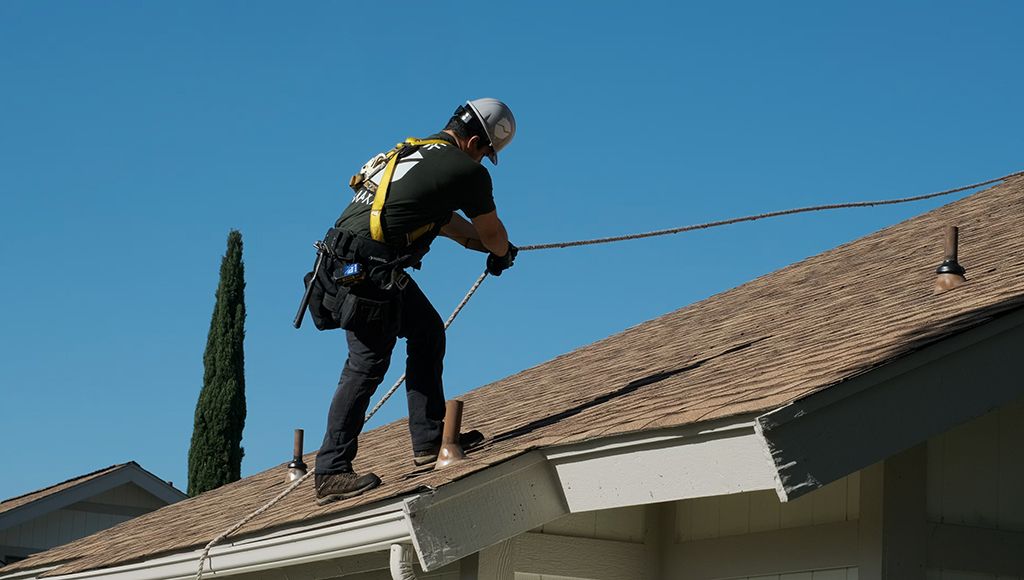Every home in Michigan wears a weather badge. It’s earned through icy wind, lake-effect snow, sudden summer storms, and the kind of spring that brings rain in bursts. And sitting on top of it all is the most weather-worn feature of your home: your roof.
Roof performance isn’t just about construction—it’s about preparation. While most homeowners only think about their roofs when something goes wrong, the smartest approach to residential roofing is seasonal. Your roof doesn’t just age by the year—it wears down by the season. And with Michigan’s ever-shifting climate, each one brings its own challenges and responsibilities.
Understanding what your roof goes through each season helps you prepare more effectively—whether that means scheduling inspections, addressing minor repairs, or evaluating your options for roof replacement.
Winter: The Ice and Pressure Phase
Michigan winters can be long, harsh, and unforgiving. Heavy snow loads, fluctuating temperatures, and ice dams put tremendous stress on roof structures. The freeze-thaw cycle can cause shingles to crack, fasteners to loosen, and water to infiltrate through microscopic gaps.
Roofs that aren’t properly insulated or ventilated often struggle to handle these extremes. Moisture trapped under the decking can refreeze and expand, leading to material separation and interior leaks. This makes winter the season that exposes weaknesses.
Homeowners should use the fall to prepare. Ice dam protection, attic ventilation, and sealing are critical strategies to consider before the first snowfall. Any roof repair done late in the season must be carefully executed to avoid further compromising materials already under strain.
And if your roof is already aging or visibly deteriorating, waiting until spring might not be a safe option. Emergency roof installation in winter isn’t ideal—but it’s far better than structural damage due to collapse or long-term leaking.
Spring: Reveal and Repair
Spring is a revealing season. As snow melts and temperatures rise, the damage done by winter comes to light.
You might spot curling shingles, visible sagging, or stains on interior ceilings. These are clear signs your roof has taken a hit. Spring is when hidden issues from the cold months emerge, and quick response is key. Neglecting spring roof repair can lead to even more expensive damage as the rainy season intensifies.
It’s also a good time to check your gutters and downspouts. Clogged drainage systems can redirect water to places it doesn’t belong—your soffits, foundation, or underlayment. Clearing them is a simple yet essential part of spring roof maintenance.
This season is ideal for scheduling a professional inspection to evaluate whether your current roof can withstand another year—or if it’s time to explore roof replacement options before summer heat arrives.
Summer: Heat, UV, and Expansion
While winter is known for its visible damage, summer takes a quieter toll. High heat and UV radiation cause roofing materials to expand, dry out, and become brittle. Shingles can warp, adhesives can degrade, and seams may widen.
If you’ve ever walked into your attic in July, you know how hot it can get under the roofline. Without proper ventilation, trapped heat will not only shorten the life of your roof—it will also increase cooling costs and strain your home’s HVAC system.
This is why summer is the season to monitor energy efficiency. A roofing system that’s underperforming can create a domino effect, raising energy bills while wearing down your equipment faster.
It’s also a key time to inspect flashing and joints around chimneys, skylights, and vents. High temperatures can loosen these seals, allowing for small leaks that are easily overlooked but harmful over time.
For homeowners considering full roof installation or replacement, summer provides optimal weather for major projects. Materials perform well, contractors can work more efficiently, and repairs are more likely to set correctly in consistent weather.
Fall: The Window for Prevention
If winter is the season of consequence, fall is the season of prevention. It’s your last chance to make sure your roof is ready to withstand Michigan’s heaviest loads.
Falling leaves can clog drainage systems, tree branches weighed down by wind can scratch or puncture shingles, and colder nights begin testing your insulation and ventilation.
This is when minor problems have the potential to become major ones. That loose shingle? That sagging section? Left unchecked, they can evolve into full-blown emergencies once snow starts to accumulate.
Fall is also an ideal time for a roofing tune-up. Minor roof repair—like tightening flashing, sealing joints, or replacing worn shingles—can extend the life of your roof and save you from winter complications. If your roof is near the end of its lifespan, this is the moment to schedule roof replacement before conditions make it harder (and more expensive).
Professionals like Best Choice Roofing of East Detroit often recommend fall as the optimal window for proactive planning. The weather is mild enough for safe work, but close enough to winter that maintenance becomes a smart defense.
Seasonal Timing Makes a Long-Term Difference
Understanding your roof’s relationship with the seasons allows you to make better decisions—not just about when to fix, but when to invest. Timing roof installation or replacement properly can prevent urgent repairs, save on utility costs, and improve the overall resilience of your home.
Many homeowners default to reacting only when there’s an issue. But residential roofing is one of those systems where a proactive approach truly pays off.
Knowing how each season affects your roof creates a habit of checking in, assessing performance, and staying one step ahead. It also builds a stronger connection with your home—turning the roof from a background feature into a front-line asset.
Final Thought: The Roof Is Always Working
Even when you’re not thinking about it, your roof is responding to the season.
It’s expanding and contracting. Deflecting wind. Holding snow. Channeling water. Filtering light. Managing temperature.
Every day, in every condition, it’s working on your behalf.
And like anything that works constantly, it needs your attention—just a few times a year, at the right moments.
When you understand the seasonal cycle of roofing, you start seeing those moments not as chores, but as opportunities. Opportunities to preserve comfort, avoid emergencies, and plan for the long haul.
Because your roof doesn’t just sit on your house.
It stands between you and the world outside.









